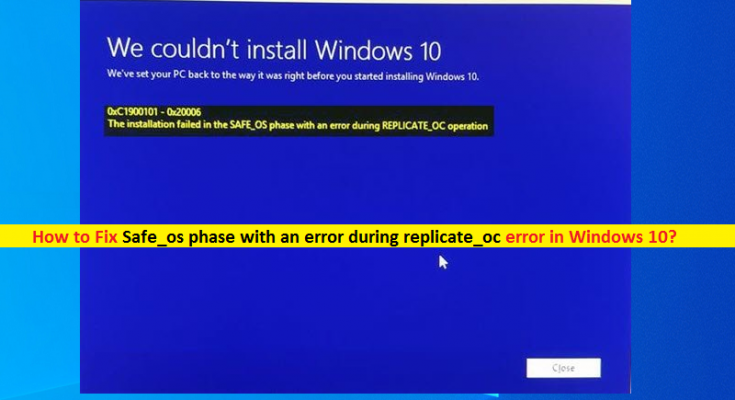What is ‘Safe_os phase with an error during replicate_oc – Windows Installation error’ in Windows 10?
If you are experiencing ‘Safe_os phase with an error during replicate_oc’ error while trying to update Windows 10 or upgrade PC from Windows 7/8.1 to Windows 10, then you are in right place for the solution. Here, you will be guided with easy steps/methods to resolve the issue. Let’s starts the discussion.
‘Windows Update/upgrade’: Microsoft releases regular updates for Microsoft Windows operating system in order to fix known bugs or issues in operating system and add several new features and enhancements to improve performances. Microsoft releases updates ever month in order to improve stability and performance, fix bugs, improve UI elements and add several new features. Microsoft also releases major updates for Windows OS in every 6-month which includes much bigger changes. For example, Windows 10 upgrade/update version 21H1 is the newest version ever at the time of writing.
However, several users reported that they faced ‘Safe_os phase with an error during replicate_oc’ error while they tried to update Windows 10 to latest version or upgrade Windows 7/8.1 computer to Windows 10. This error prevents you from installing newest updates or newest Windows version. This error is also appeared usually when you try to use Windows Media Creation Tool to perform upgrade. Let’s take a look at error message.
“We couldn’t install Windows 10
We’ve set your PC back to the way it was right before you started installing Windows 10
0x8007001F – 0x20006
The installation failed in the Safe_os phase with an error during replicate_oc operation”
There could be several reasons behind this issue including issue with external peripheral devices that are connected to your computer via USB, old migration files that are stored in System32 folder of your Windows Installation, Developer Mode package that resides on your computer, corruption in system files or hard disk system image and other reasons. This error is appeared usually due to interference of some problematic hardware attached/connected into computer like external peripheral devices connected via USB.
You can unplug all unnecessary devices from computer and then retry updating/upgrading Windows 10 and check if it works for you. Also, this error is appeared if there is old migration files stored in System32 folder of your Windows installation. You can rename them so that Media Creation Tool can create new migration files in order to fix the issue. You can run DISM Scan and SFC scan tool in Windows 10 in order to fix corruption in hard disk system image and corrupted system files. Let’s go for the solution.
How to fix Safe_os phase with an error during replicate_oc in Windows 10?
Method 1: Fix ‘Safe_os phase with an error during replicate_oc’ with ‘PC Repair Tool’
‘PC Repair Tool’ is easy & quick way to find and fix BSOD errors, DLL errors, problems with programs/applications, malware or viruses issues, system files or registry issues, and other system issues with just few clicks. You can get this tool through button/link below.
Method 2: Run ‘Windows Update’ troubleshooter in Windows 10

Windows 10 build-in ‘Windows Update’ troubleshooter can resolve this issue. Let’s try.
Step 1: Press ‘Windows + I’ keys on keyboard to open ‘Settings’ App in Windows 10
Step 2: In ‘Settings’ App, go to ‘Update & Security > Troubleshoot’, in right pane, click on ‘Additional Troubleshooters’ if you can’t find ‘Windows Update’ troubleshooter
Step 3: Find and select ‘Windows Update’ troubleshooter, and click ‘Run the troubleshooter’ button. Follow on-screen instructions to finish troubleshooting. Once done, retry updating/upgrading Windows PC and check if it works for you.
Method 3: Update Windows drivers
This issue can also be occurred due to corrupted/outdated or incompatible drivers installed in computer. Updating all necessary Windows drivers to latest version can resolve the error and after updating drivers, retry updating Windows 10 and check if the issue is resolved. You can try to update all Windows drivers including graphics card drivers and others with ‘Automatic Driver Update Tool’. This software will automatically find and download the latest updates for all Windows drivers and then install them into computer.
Update Windows drivers using Device Manager:
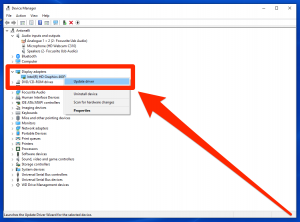
Step 1: Type ‘Device Manager’ in Windows Search box and open it from results appear
Step 2: In Device Manager, expand each device category one-by-one and look for the device showing ‘Yellow Exclamation Mark’ on it, right-click on device with Yellow Mark, and select ‘Update Driver’.
Step 3: Follow on-screen instructions to finish update. Repeat the same steps to update all other necessary drivers. Once done, restart your computer and check if the issue is resolved.
Method 4: Check if Windows update related services is set to start automatically
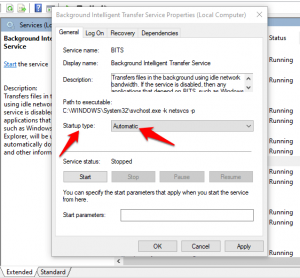
Step 1: Press ‘Windows + R’ keys on keyboard, type ‘services.msc’ in the opened ‘Run’ dialog box and hit ‘Ok’ button to open ‘Services’ window
Step 2: In ‘Services’ window, find and double-click on ‘Background Intelligent Transfer Service (BITS)’ service to open its ‘Properties’. In ‘Properties’ window, select ‘Automatic’ from ‘Startup Type’ dropdown and hit ‘Start’ button under ‘Service Status’ section, and then hit ‘Apply’ and ‘OK’ button to save the changes
Step 3: Repeat the same steps for ‘Windows Update’ and ‘Cryptographic Service’ services. Once done, restart your computer and check if it works for you.
Method 5: Perform Windows Update components
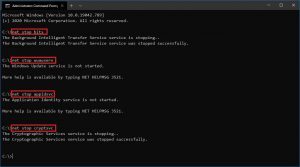
This issue can also be occurred due to corruption Windows update components. You can reset Windows update components in order to fix the issue.
Step 1: Press ‘Windows + X’ keys on keyboard and select ‘Command Prompt as Administrator’
Step 2: Type the following commands one-by-one and hit ‘Enter’ key after each to execute
net stop bits
net stop wuauserv
net stop appidsvc
net stop cryptsvc
Step 3: Once executed, open ‘File Explorer’ and locate the following paths one-by-one and delete all contents inside the folder.
C:\\Windows\\System32\\catroot2
C:\\Windows\\SoftwareDistribution
Step 4: After that, back to ‘Command Prompt’ window, type the following commands one-by-one and hit ‘Enter’ key after each to execute
regsvr32.exe /s atl.dll
regsvr32.exe /s urlmon.dll
regsvr32.exe /s mshtml.dll
netsh winsock reset
netsh winsock reset proxy
net start bits
net start wuauserv
net start appidsvc
net start cryptsvc
Step 5: Once executed, restart your computer and check if the issue is resolved.
Method 6: Run Memory Diagnostic Tool in Windows 10
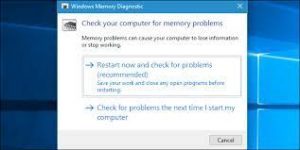
You can check if there is no issue with RAM memory using Windows Memory Diagnostic Tool.
Step 1: Type ‘Windows Memory Diagnostic’ in Windows Search and open it from results appear
Step 2: In the opened window, click on ‘Restart now and check for problems (recommended)’ option. This will restart your computer and start scanning for RAM issue.
Step 3: Once your computer is restarted, please check if the issue is resolved.
Method 7: Use Media Creation Tool to update/upgrade Windows PC
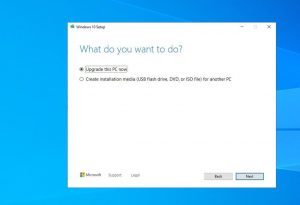
Step 1: Open your browser and visit ‘Microsoft Official site’ or visit ‘https://www.microsoft.com/en-us/software-download/windows10’ page to download Windows Media Creation Tool in your computer
Step 2: Once downloaded, double-click on downloaded setup file and install the tool
Step 3: Now, launch Windows Media Creation Tool and select ‘Upgrade this PC now > Next’. Wait till all files are downloaded
Step 4: This will restart your computer several times and once done, please check if the issue is resolved.
Method 8: Perform Windows 10 reset

If the issue is still persist, then you are try to fix the issue by performing Windows reset
Step 1: In Windows 10, open ‘Settings’ App and go to ‘Update & Security > Recovery > Reset This PC’ and click on ‘Get Started’ button
Step 2: Select ‘Keep my files > Cloud Download’ and follow on-screen instructions to finish resetting process. Once done, restart your computer and check if the error is resolved.
Method 9: Disconnect external peripheral devices
This issue can also be occurred due to external peripheral devices connected into your computer via USB. Hardware issue could reason behind this type of error. To fix this issue, you can remove all peripheral devices and keep connecting only mouse and keyboard, and check if it works for you. You can perform Windows update/upgrade with mouse and keyboard only peripheral devices. However, if you want to connect more devices, then you need to connect each device one-by-one and make sure it is not problematic.
Method 10: Renames old Migration Files in Windows Installation folder
You can also fix this issue by renaming old migration files that are stored in System32 folder inside Windows Installation folder. This will help you to create new migration files and prevent from interfering with the process.
Step 1: Open ‘Command Prompt as Administrator’ using ‘Method 5’
Step 2: Type the following commands one-by-one and hit ‘Enter’ key after each to execute.
ren C:\Windows\System32\migration migration.old
ren C:\Windows\System32\migwiz migwiz.old
Step 3: Once executed, close Command Prompt and retry upgrading/updating Windows and check if it works for you.
Method 11: Remove Developer Mode Package
You can remove Developer Mode package via DISM scan tool in Windows computer in order to fix the issue.
Step 1: Open ‘Command Prompt as Administrator’ using above method
Step 2: Type or copy & paste the following command and hit ‘Enter’ key to execute
dism /online /remove-package /packagename:Microsoft-OneCore-DeveloperMode-Desktop-Package~31bf3856ad364e35~amd64~~10.0.17134.1
Step 3: Once executed, check if the error is resolved. If you get ‘Not Found’ or similar error while attempting to execute the above command, it may be due to different version of package. So, copy the command till Microsoft-OneCore-DeveloperMode and then press ‘TAB’ key on keyboard to autofill the test. And then execute the command.
Conclusion
I am sure this post helped you on How to fix Safe_os phase with an error during replicate_oc in Windows 10 with several easy steps/methods. You can read & follow our instructions to do so. That’s all. For any suggestions or queries, please write on comment box below.
